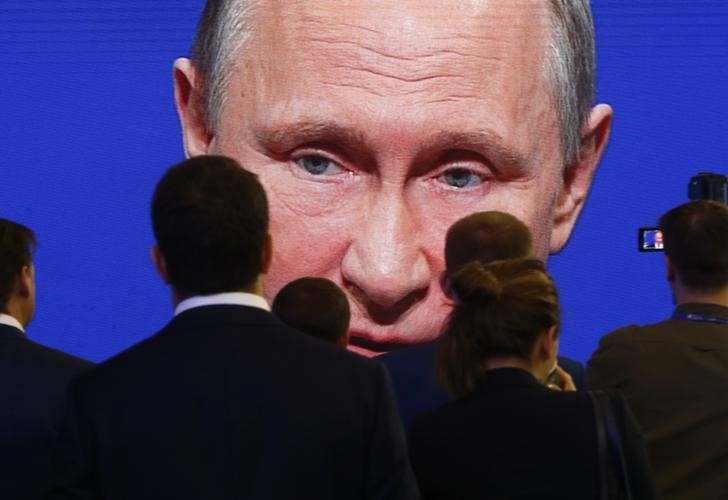(Bloomberg) -- The trail of destruction left by American sanctions against Russia’s most influential oligarchs spread to President Vladimir Putin’s government as surging borrowing costs forced the Finance Ministry to pull a planned bond sale.
It’s the first debt auction that Russia is abandoning since cancellations in 2014 and 2015, when Putin’s annexation of Crimea soured relations with the U.S. and European Union. As panic spreads over how far America will go at blacklisting wealthy Russian businessmen, the ruble and bonds are tumbling.
“It’s finally sinking in that the U.S. Treasury actions are a major game changer in terms of how one should view Russian market risks," said Timothy Ash, a senior emerging-market strategist at BlueBay Asset Management LLP in London. "The U.S. administration made it clear that no Russian oligarch can now escape."
The latest penalties are notably worse than earlier ones because they bar any trading of securities in two Russian companies instead of just limiting new equity and debt sales. Targets include billionaire Oleg Deripaska, who runs one of the world’s biggest aluminum companies, United Co. Rusal -- which lost half of its market value in Hong Kong on Monday alone.
Global companies are rushing to distance themselves from the blacklisted oligarch. Glencore (LON:GLEN) Plc, the world’s largest commodities trader, said on Tuesday it’s scrapping a plan to swap its stake in Rusal for shares in another one of Deripaska’s companies, London-listed En+ Group Plc. Its chief executive officer, Ivan Glasenberg, also resigned from Rusal’s board.
The impact of Friday’s sanctions were felt through the commodities industry. Aluminum extended its biggest two-day gain in more than six years on concern production from Rusal will be prevented from reaching global markets.
Russia ‘Outgunned’
The ruble depreciated 3.5 percent to 62.75 versus the dollar, taking its decline this week to 7.2 percent. Russian stocks rose 3.5 percent, only partly reversing an 8.3 percent slide on Monday, mostly because other non-sanctioned exporters benefit from the weaker currency since their earnings are in dollars and costs are in rubles.
"My sense, is that economically at least, Russia is outgunned and they will seek to save face and not exacerbate the situation," said Julian Rimmer, a London-based emerging-markets trader at Investec Bank Plc. "My advice to clients, therefore, is to buy shares into this weakness, especially Sberbank, and hold onto your shapka."
So far, Russian officials aren’t panicking, saying the sanctions pose no threat to financial stability and don’t require any response from the authorities. The ruble’s floating exchange rate helps the economy adapt to shocks and the central bank can use interest rates to offset any increase in inflation caused by currency weakness, central bank Governor Elvira Nabiullina said at a conference in Moscow.
In December 2014 when the ruble went into free fall, she did just that -- hoisting borrowing costs by 650 basis points overnight in a move that eventually calmed market panic. On Tuesday, the Bank of Russia said it won’t hesitate to sell dollars if needed.
There was little reprieve on the bond market, especially since it’s not just sanctions that Russia is up against. Escalating tensions between Russia and the U.S. over the conflict in Syria are also giving traders cause for concern.
President Donald Trump said the U.S. will respond “forcefully” to a suspected chemical weapons attack by Syrian President Bashar al-Assad’s regime over the weekend, after suggesting earlier that Putin may share responsibility.
Yields on government ruble-denominated debt due in January 2028 surged 22 basis points to 7.54 percent. Russia’s Finance Ministry cited unfavorable market conditions in its first decision to scrap a debt sale since August 2015. The cost of insuring Russian dollar debt against default surged to the most since August.
"The message to Western institutional investors is now clear -- you hold Russian securities at your own risk. You have been warned," said Ash.
